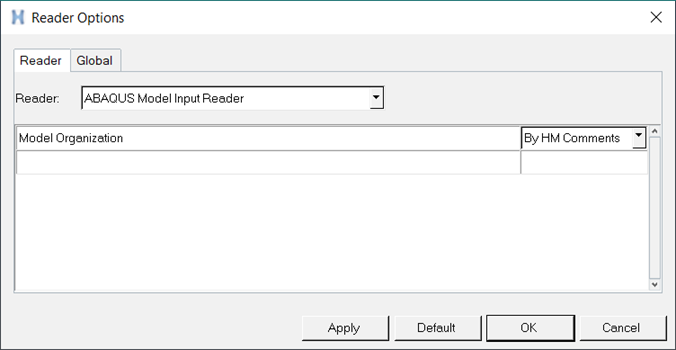Load Model
Use the Load Model tool to load model and result files.

Figure 1.

Figure 2. Load Model panel
See the Supported File Types topic for a list of supported animation files.
- Loading Multiple Result Files
- Multiple result files for the same model file can be loaded by clicking on the
Add multiple result file icon
 . This is useful in cases where you have several result files,
each containing a different load configuration for the same base model, and you want to
bring all of the results into a single session.
. This is useful in cases where you have several result files,
each containing a different load configuration for the same base model, and you want to
bring all of the results into a single session. - Overlay Multiple Models
- You can load one or more models and their associated results into one window by
activating the Overlay check box. The last model you load automatically becomes the
current model. To make a previous model the current one, you must manually set it as
your current model. From the Results Browser, right-click on the
name of the model file that you would like to set as the current model, and select
Make Current from the context menu.
You can also delete the model specified as the current model from the Results Browser, by right-clicking on the name of the model file, and selecting Delete from the context menu.
If you select a result file for a model, HyperView assumes that the result comes from the same file and automatically updates the selection in the results field.
If a results file, such as an ADAMS .gra file, contains more than one data block, a dialog is displayed that allows you to select the desired block.
Import Options
- Result-Math
-
Result-Math template Enable/disable the available result math templates. Use the drop-down menu to select one of the following result math templates: None If a model/result is loaded when this option is selected, the result math capabilities will be disabled. Advanced The result math template for advanced use cases. Composite The result math template for composite use cases NVH The result math template file for NVH use cases. Standard The result math template file for general use cases (non-advanced). This option is enabled by default. - Model Reader
- Use this to determine how components are created during the import of a model file, by
selecting the model organization option for each reader. Currently the model reader
import options that are supported are for Abaqus, Nastran, and OptiStruct models only.

Figure 3.Each solver model reader may work differently for each of these options, however the overall general behavior is as follows:- The By HM Comments option honors the HyperMesh comments in the selected file that was created by HyperMesh in any previous export of the model.
- The By Property option ignores any HyperMesh comments that may be in the selected file and will automatically create components based on each property in the file. The component name will be the name of the property.
- The By 1 Component option ignores any HyperMesh comments that may be in the selected file and will create one component into which all elements in the selected file will be organized.
- Result Reader
- Use this to determine how components are created during the import of a model from a
result file, by selecting the model organization option for each reader.
- The By Default option creates components based on element type, property, and material cards.
- The By Material option ignores any HyperMesh comments that may be in the selected file and will automatically create components based on each material in the file. The component name will be the name of the material.
- The By Property option creates component based on property. Element type and Material cards are ignored.
- The By 1 Component option creates one component and put all elements into this component.
Note: Please refer to the corresponding Abaqus, Nastran, or OptiStruct documentation for additional details. - Global
- Use this to set certain global options irrespective of the type of model/result files
being loaded.
Currently an option is provided to convert 2nd order elements to 1st order elements. During the model load, all 2nd order elements in the model file will be converted to 1st order elements by disconnecting the mid-side nodes on those elements. Please note that the element is then treated as a 1st order element when plotting results and mid-side results, if they exist, will be ignored.